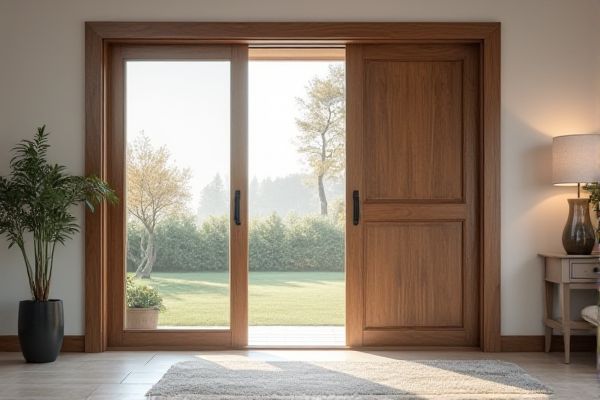
Sliding doors save space by gliding along a track, making them ideal for compact areas, while hinged doors swing open, offering a traditional look and easier access to wider openings. Explore the rest of the article to discover which door type best suits your home's style and functionality needs.
Table of Comparison
| Feature | Sliding Door | Hinged Door |
|---|---|---|
| Space Efficiency | Maximizes floor space; slides parallel to wall | Requires clear swinging area; less space-efficient |
| Installation | Complex track and rollers installation | Simple hinge installation, easier for DIY |
| Maintenance | Requires periodic track cleaning and roller lubrication | Low maintenance; hinges may need occasional oiling |
| Accessibility | Easy to operate; ideal for tight spaces | Wide opening; good for accessibility |
| Cost | Generally more expensive due to hardware | Usually less costly and affordable |
| Aesthetic | Sleek, modern look | Classic and traditional appearance |
| Noise | Can be quieter if rollers maintained | May produce creaking without maintenance |
| Security | May require additional locks for security | Generally secure with traditional lock systems |
Introduction to Sliding and Hinged Doors
Sliding doors maximize space efficiency by gliding along tracks, making them ideal for areas where floor space is limited. Hinged doors offer a classic design that swings open on hinges, providing a wide and unobstructed entryway. Your choice between sliding and hinged doors depends on factors like room layout, aesthetic preference, and functionality requirements.
Design and Aesthetic Differences
Sliding doors offer a sleek, modern design that maximizes space with their minimalist tracks and large glass panels, creating an open and airy aesthetic. Hinged doors provide a traditional look with defined frames and a variety of materials and finishes, complementing classic or ornate interior styles. Your choice between sliding and hinged doors will impact the room's visual flow and style, balancing contemporary elegance against timeless charm.
Space Efficiency Comparison
Sliding doors offer superior space efficiency compared to hinged doors by gliding along the wall rather than swinging open, saving valuable floor space. Hinged doors require a clear area to swing inward or outward, which can limit furniture placement and room layout options. Your choice of sliding door can maximize usable space in tight or compact areas, enhancing overall room functionality.
Installation Process and Requirements
Sliding doors require a track system installed above or below the door frame, often needing professional alignment for smooth operation and sufficient wall space for the door to slide open. Hinged doors involve simpler installation, requiring hinges mounted on a door jamb and space for the door to swing open without obstruction. Sliding doors demand precise measurements and structurally reinforced frames to support the track, while hinged doors need standard framing and clear floor space.
Durability and Maintenance
Sliding doors feature a durable track system that requires regular cleaning and lubrication to prevent wear and ensure smooth operation, while hinged doors typically need less frequent maintenance but may suffer from hinge wear or misalignment over time. Both options use sturdy materials like aluminum, wood, or fiberglass, but sliding doors often demonstrate longer lifespan in high-traffic areas due to their low-impact operation. You should consider easy access for routine maintenance when choosing between sliding and hinged doors to maximize durability and performance.
Cost Analysis and Budget Considerations
Sliding doors typically cost more upfront due to specialized tracks and installation, but they save space, potentially reducing room renovation expenses. Hinged doors are generally less expensive initially, with simpler installation and hardware, making them budget-friendly for straightforward projects. Your choice should balance long-term space efficiency against initial cost constraints to optimize your overall budget.
Functionality and Accessibility
Sliding doors maximize functionality by saving space and providing smooth, wide openings ideal for tight areas, while hinged doors offer straightforward installation and better sealing for privacy and noise reduction. Accessibility improves with sliding doors due to effortless gliding mechanisms beneficial for mobility devices, whereas hinged doors provide clear, unobstructed entry when fully opened. Your choice depends on prioritizing space efficiency and ease of access versus traditional operation and enhanced insulation.
Security Features and Performance
Sliding doors often feature multi-point locking systems embedded along the frame, enhancing security by distributing force evenly to prevent forced entry. Hinged doors typically rely on robust deadbolts and reinforced strike plates for resistance against break-ins, offering superior performance in withstanding impact. Your choice depends on whether ease of use and space-saving sliding doors meet your security needs or if the solid structure of hinged doors better supports your protection requirements.
Energy Efficiency and Insulation
Sliding doors often feature multi-pane glass with insulating gas fills and low-E coatings, enhancing thermal performance by reducing heat transfer and preventing drafts. Hinged doors, especially those with solid cores and weatherstripping, typically offer superior airtight seals that minimize energy loss more effectively than sliding doors. For optimal energy efficiency and insulation, selecting doors with advanced materials, proper installation, and quality seals is essential regardless of door type.
Choosing the Right Door for Your Space
Sliding doors maximize space efficiency by gliding along tracks without requiring clearance for swinging, making them ideal for compact areas or rooms with limited floor space. Hinged doors offer a classic design with a full range of motion, providing better sealing and security, suitable for traditional layouts and rooms requiring a tight closure. Consider room size, functionality, and aesthetic preferences when choosing between sliding and hinged doors to optimize usability and style in your space.
 homyna.com
homyna.com